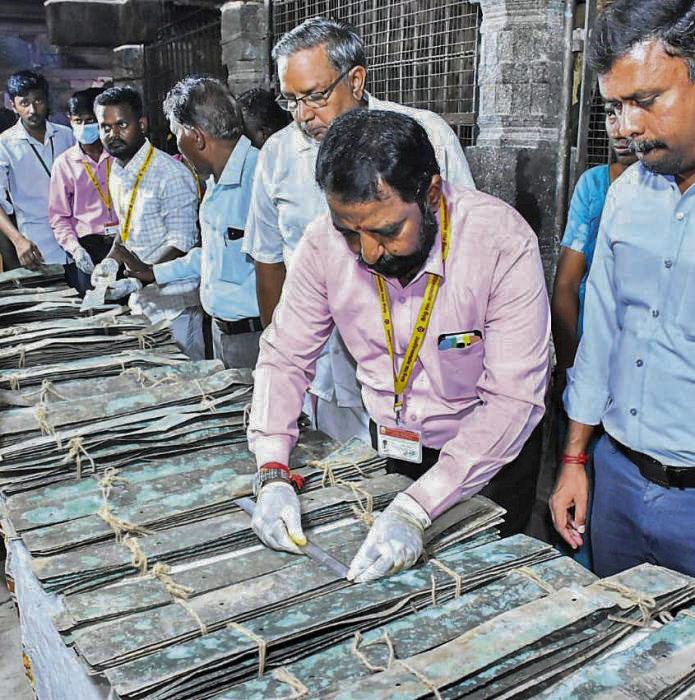Long-lost hymns from revered 7th-century Saivite saints may be among the treasure
By S. Krishnan, Tamil Nadu, India
The discovery of a number of statues and copper plates in Seerkazhi Sattainathar Temple is a landmark event—the first discovery of copper plates inscribed with ancient Saiva hymns. The temple is under the administration of Dharmapuram Aadheenam, a centuries-old Saiva mutt. The aadheenam is currently performing kumbhabhishekam (consecration ceremony) at a number of temples under its control. The one for Sattainathar Temple, 150 miles south of Chennai near the coast, was held on May 24, 2023, after a gap of 32 years.
While digging a place for constructing the yagasala (covered ritual area) for the event near the west gopuram, workers found bronze artifacts. The digging was stopped, then resumed carefully under the supervision of the head of the aadheenam, Sri Masillamani Desiga Gnanasambanda Swamigal. What was unearthed was a treasure trove.
There were 22 panchaloka (“five metals”) murtis including those of Ganapati, Murugan, Somaskandar and Saiva saints such as Appar and Gnanasambandar. In addition, the workers uncovered 55 pedestals, a number of puja utensils and 493 copper plates.
Based on the initial assessment, the murtis were are from the 12th-13th century ce, towards the end of the later Chola era. The style of Tamil letters written on the copper plates indicates they are from the same period.
Apparently they were buried to safeguard against invader attacks, then lost for centuries. Initial reading of the copper plates on display shows that one is a devotional song, the Thiruvenguru hymn by Saint Sambandar. He was born in Seerkazhi in the 7th century, one of four renowned saints of the time.
A number of copper plates of Pandyas, Cholas, Pallavas and other kings who ruled the Tamil area during this period have been found previously, but those all deal with grants to individuals or temples. This is the first time copper plates with Saiva hymns have been found. These hymns, immensely popular and collectively known as the Thevaram, were sung by Saiva saints Appar, Sundarar and Sambandar during the 7th and 8th centuries. It is said there were originally 38,000 such hymns. Most were lost over the succeeding centuries with about 8,227 recovered due to the efforts of Emperor Rajaraja Chola (985 to 1014 ce), recorded on palm leaves discovered in one of the rooms in the Chidambaram Nataraja temple. Even then, many of the manuscripts had been damaged or destroyed by termites. Rajaraja Chola took the help of Nambiyandar Nambi to arrange them properly into categories of songs, giving us today’s Thevaram collection, one of Saivism’s great devotional compendiums.
New palm-leaf manuscripts of the hymns were made and distributed widely. Ever since then, the songs have been sung on a grand scale in many temples. Grants were given to Othuvars (experts hymn singers) to sing them on important occasions. Rajaraja Chola employed 48 Othuvars in Thanjavur temple alone. Over the centuries, as they were written only on palm leaves, a few of these hymns were again lost, in whole or in part.
According to an inscription in stone at the Chidambaram Nataraja temple, Vikram Chola, who ruled from 1118 to 1135, had the hymns inscribed on copper plates. A 12th-century inscription in Atroor, near Tiruchendur, also mentions hymns by Appar, Sambandar and Sundarar being inscribed on copper plates.
Until this recent discovery, no such plates had ever been found. Potentially, they couold assume an immense place in the religious history of Tamil Nadu. Currently, the plates are under the analysis of experts. What will be most interesting to know is if they contain hymns unknown to us so far. ∏π
This article by S. Krishnan originally appeared in Swarajya magazine: bit.ly/seerkazhiplates. Edited for length and clarity.
